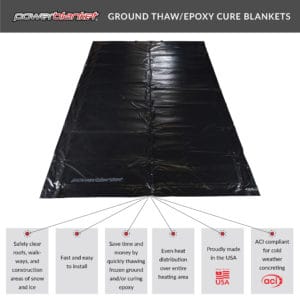If you’re a fan of HGTV and DIY shows, you’ve probably seen plenty of home improvement projects using epoxy resin. Epoxy resin is an adhesive that combines two separate components: a resin and a hardener. They chemically react to form a solid, cross-linked polymer. Some formulas dry into a hard, clear finish; others are gray, brown, or black.
Resin has many uses, from artistic projects to large-scale industrial processes. It can be molded as a solid, used as a coating on something else, or mixed with other resins to create new compounds. Unfortunately, if you are in a hurry, it takes time to cure epoxy resin properly. If it’s part of a manufacturing method, you can’t move to the next step unless it cures completely.
Before we discover how long epoxy resin takes to dry, we’ll show you what’s involved with curing epoxy.
What’s The Process For Curing Epoxy?
Epoxy is a chemical reaction between two agents, the resin and the hardener or curing agent. Both compounds are liquids or gels until mixed. As soon as they combine, a chemical reaction creates heat and turns the mixture into a hard solid. For more details, go to our blog, What is Epoxy Made Of?
After pouring or applying the resin, it needs time to cure. It’s a chemical reaction between the hardener and resin that makes it harden fully. Curing is critical to the resin-application process, and there are various ways to do it:
UV light curing – UV light curing uses a UV lamp that can harden epoxy in as little as 30 seconds. However, not all resins are alike, and not all UV lamps have the same strength. It’s important to note that UV light curing machines are expensive and can range between $500 and $1000. Check with the manufacturer about curing with UV light for a specific product.
Hot curing – Hot curing is a technique that allows you to cure your resin faster with applied heat. Hot curing can take between 5 and 10 minutes, depending on the resin you’re using. The heat source should be steady, such as an oven, radiant heater, or epoxy curing blanket.
Heat Guns – To heat cure resin for small parts, a hair dryer, infrared lamps, or heat gun can work, but these methods can be hit and miss. They may not heat the part evenly, making it challenging to ensure the pieces have been heated to the correct temperature for the recommended time. You’ll need to check the hardness of the cured product.
Warmer Temperatures Facilitate Curing
Higher temperatures can reduce curing times. One epoxy product that can bond iron to iron lists three curing times depending on the temperature applied:
- 180 minutes at 60°C
- 50 Minutes at 70°C
- 20 minutes at 80°C
As you can see, the higher the temperature, the faster the cure rate.
Epoxy undergoes three stages when curing: liquid, gel, and solid. Epoxy resin drying times depend on the specific type of resin, the hardener, and the surrounding temperature.
Powerblanket epoxy curing blankets provide even, customizable heat for your resin projects. Shorten cure times from days or weeks to just minutes or hours while ensuring consistent results. Our patented thermal technology allows for precision temperature control tailored to your specific resin’s curing requirements.
How Long Does Epoxy Resin Take To Dry?
It can take a few hours to two weeks to fully cure, depending on several factors, such as the type of resin, the temperature, humidity, and the amount of sunlight or UV rays penetrating the surface.
Epoxy resins are among the hardest to cure fully because they contain several different chemical compounds. Epoxy resins take longer to harden because the prepolymer and the catalyst must react to create the adhesive.
How Do You Know When the Resin Has Cured?
The resin should feel dry to the touch, not tacky when cured. If you have some leftover resin in a cup, use that to check if it has hardened rather than touching or unmolding the finished project.
Commercial durometers measure hardness by pressing it into a sample of at least 1/8” thick. Epoxies use a scale called Shore D. The scale is 0 to 100, and the reading of cured epoxy should be at least 60 or higher.
How Long Does 2-Part Epoxy Take to Dry?
The drying time for resin and hardeners varies. We recommend checking with the manufacturer’s instructions. If your shop is less than 70°F, it will take longer. To expedite curing, raise the temperature in the work area or apply additional heat to the project.
Times It Takes For Epoxy Resin To Be Fully Cured
Depending on the thickness of the epoxy resin and the other factors mentioned above, a complete cure can take anywhere from a few days to a few weeks.
For most projects, you’ll want to wait at least two days for the thickest layer of epoxy to cure. To fully harden, you may need to wait at least two weeks.
Why Does Epoxy Resin Take So Long To Cure?
If an epoxy resin takes longer to cure, it could be affected by various factors such as:
- Measuring was inaccurate, and the ratio is incorrect by weight, volume, or the scale wasn’t tarred for the container.
- The mixing process was not thorough and not 100% homogeneous. The molecular chain is not fully closed, causing less SHORE D hardness and soft spots.
- Not using a straight-side container can affect measurements if the container is smaller at the bottom and larger at the top.
- Lower temperatures. Each degree under 72F/22C will slow the curing process by 15-25%.
Is There a Way to Get the Resin to Cure Faster?
With some epoxy formulas, you can add a catalyst to help the phenolic resin harden faster. The catalyst will vary depending on the brand and type of resin. It’s always best to read the instructions or check with the manufacturer before adding anything.
Raising the temperature of the air around the resin is a sure method to cure it faster. Applying heat of 176°F (80°C) or more can significantly reduce the epoxy resin drying time.
Powerblanket epoxy curing blankets are the most efficient epoxy curing solutions. They provide even heat directly to the project. There is no wasted heat, and they can produce temperatures up to 180° F (82.2°C) at only 80 watts per square foot.
The Safest Way to Reduce Curing Times
When it comes to epoxy curing time, increasing the temperature by 20°to 30°F more can reduce the curing time by up to 30%. Additionally, for an incremental rise of 20°F (~11°C), the cure rate time decreases by as much as 20 to 25%.
Some industrial heating applications include ovens, variable-frequency microwaves (VFM), induction ovens, heat lamps, or heat guns. Ovens are expensive to purchase, require a lot of space, and can be costly to run. Localized heating methods like heat lamps and flame guns can cause uneven heat resulting in an uneven cure. They also present a fire hazard.
Projects can’t move forward because of lengthy epoxy curing times. The safest and fastest way to dry resin and reduce costs are with epoxy curing blankets.
Epoxy Curing Blankets Explained
Powerblanket epoxy curing blankets come to the rescue for companies needing more control of the curing process. An epoxy curing blanket has an electrically heated core that produces a maximum internal temperature of 200 ± 9°F (93 ± 5°C). It has a layer of insulation on one side and a heat-spreading layer on the other that faces the epoxy resin. The blanket has chemical and tear-resistant outer coverings on both sides.
Covering the project’s surface with a heated blanket reduces the curing time significantly. For custom solutions up to 400° F and 700 watts, contact Powerblanket.
Metadata
Providing additional heat with an epoxy blanket is the best way to ensure a fast and consistent cure time. Discover the other factors that affect resin drying times.
Cure your epoxy resins faster and easier than ever before with Powerblanket.



